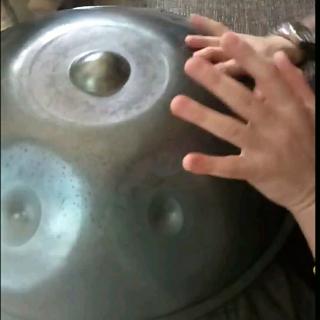
介绍:
《Introduction of Handpan/Hang手碟簡介》
Editor/Interpreter/Translator: Padma
名称:手碟
发明人:Felix Rohner,Sabina Schärer
出现时间:2000年
出现地区:瑞士
乐器属性:打击乐器
外文名称:Hang
一个类似UFO的金属乐器
手碟(Hang)是一种打击乐器,由两名瑞士人菲力‧霍那(Felix Rohner)和萨宾娜‧谢雷(Sabina Schärer)于2000年所创。手碟由两个半球型的钢模通过氮作用过程(gas-nitriding)组合而成,形同UFO。其上部有八到九个音,中心点为基础音Ding,其余七或八个音环绕分布。底部的中心有个孔,为低音Gu,也可为调音用。
乐手多将手碟置于盘腿上,以手掌,手心拍打或手指敲点出声,也可置于立架上,不同于钢鼓(Steelpan)以槌敲击,声音也较钢鼓(Steelpan)细柔温暖。手碟依乐手的手法,声音可能类同竖琴、钟,或是调过音的钢鼓(Steelpan)。每个"音场" (Tone Field) 在基础音的周围有几个泛音共鸣区。
操作步骤
左手持短的一头,向上翻九十度,从下面穿过来,穿进“又”字的空里,拉紧,保持左手持短的部分,就可以看见一个纸星星的原形。长的部分一层一层均匀的缠在纸星星上,使其变厚,它是可以贴得很紧密的,如果长的一端没有很严密的缠在上面,就换一条边。最后把短的一点边用长的最后一点压住,再把长的剩余一点纸边放进去,把各个角用手挤出来,就成形了。
创造发展
由瑞士人 Felix Rohner 与 Sabina Scharer (PANArt Handpan AG) 共同研发, 2001年在法兰克福乐器展上亮相。两个半球型的钢模,透过氮作用过程 (gas-nitriding),增加钢的轫度。一般认定为底部的中心有个孔,称 Gu 之,为低音部,其构造以亥姆霍兹共鸣器(Helmholtz·Resonator)原理设计,Gu 也为调音用。音高的改变类同 Talking Drum。手碟的上部有7个音,绕中心点基础音 Ding,从低至高以Z字排列,各音阶与主体的
亥姆霍兹共鸣器 (Helmholtz·Resonator)
产生共鸣。
8个音环的手碟已停产。
目前世界上除了他們两个人知道如何制作 Hang,也就是创作人菲力·霍那(Felix Rohner)与萨宾那·谢雷(Sabina Scharer),每一个手碟都出自他们伯恩的工作室,2000年至2005年间,设计了约 15 至 45 种不同的音环,中心Ding的音高从F3至A3都有,这是第一代的手碟。
中國可以製作手碟音樂人為數不多,其中之一就是Selfawaken自覺樂隊創始人昊翰老師【In Picture中……】。
灵感来自于人类音乐学,民族乐器中的五声调式。2006年起,第二代的手碟在氮化钢表面镀了一层铜,亥姆霍兹共鸣器的基础音定于D2,中心Ding为D3,往下5阶为音环中最低音A3,包括其8个度音阶中的D4与A4,以上是所有手碟的音阶结构,Gu多定为D5,但调音者保有4个音阶可自由发挥, 手碟各部位形成的频谱一如陶罐鼓的神秘声音。一个8度音阶里,手碟的音乐是音程的调色盘,非常适合人声一起演译;手与鼓面的互动是手碟乐手最重要的表达方法。
Introduction of Handpan/Hang
Name: Handpan
Inventors: Felix Rohner, Sabina Scharer
Date of Occurrence: 2000
Region: Switzerland
Instrument property: percussion instrument
Foreign name: Hang
A metal instrument resembling a UFO
Hang is a percussion instrument created in 2000 by two Swiss, Felix Rohner and Sabina Scharer. The handball is a combination of two half-ball steel molds in the form of a UFO via a gas-nitriding process. There are eight to nine notes on the upper part, and the central point is the basic tone Ding. The other seven or eight notes surround the distribution. There's a hole in the center of the bottom for the bass Gu, or for tuning.
Players often place their dishes on their legs and tap out with the palm of their hands, palm tapping or finger tapping. They can also be placed on a stand, where the sound is softer and warmer than the steelpan's hammer. The sound may be similar to that of a harp, a bell, or an tuned steelpan. Each "Tone Field" has several harmonic areas around the base tone.
Playing for Steps
Hold the short end of the left hand, turn it 90 degrees upwards, run through the space of the word "again" from below, pull tight, keep the short part of the left hand, and you can see the original shape of a paper star. The long part is evenly wrapped around the paper star layer by layer, making it thicker, it can stick very tightly, if the long end is not tightly wrapped around it, change a side. Finally, the short side with the last point long pressure, and then the long remaining edge of the paper put in, the corners of the hand out, forming.
Create a development
Developed by Swiss Felix Rohner and Sabina Scharer (PANArt Handpan AG), it was unveiled at the Frankfurt instrument fair in 2001. Two hemispherical steel molds that increase steel toughness through a gas-nitriding process. It is generally believed that there is a hole in the center of the bottom, called Gu, for bass, which is designed on the principle of Helmholtz·Resonator, and Gu is also used for tuning. Pitch changes are similar to talking drum. There are 7 tones on the upper part of the disc, around the base note of the center point, arranged in Z from low to high, and the scales resonate with the Helmholtz·Resonator of the subject.
8 sound ring has been discontinued.
At present, there are only two people in the world who know how to make Handpan. Felix·Rohner and Sabina·Scharer, who produced each of the discs at his studio, designed about 15 to 45 different sound rings between 2000 and 2005, with central Ding's pitch from F3 to A3, the first of its kind.
One of the few musicians in China who can make Handpan is Haohan, the founder of Selfawaken Band.
The inspiration comes from human musicology, the five-tone mode of national instruments. Since 2006, the second generation of the hand disc in nitrided steel surface with a layer of copper plating, the basis of Helmholtz·Resonator is scheduled for D2, center for D3, Ding down 5 lowest note in order for sound ring A3, including its eight degrees of scales of D4 and A4, above is all hand dish scale structure, Gu as the D5, but kept four scales can free play, each part of the hand disc formation spectrum as the mystery of pottery drum sound. In an 8-degree scale, the music of the hand disc is a palette of intervals, perfect for human voices. The interaction between the hand and the drum is the most important expression of the hand disc player.
上一期: 昊翰詞曲唱《有一個人There's a Man》@《Love-Compassion》
下一期: 昊翰等世界手碟演奏家《手碟歷史與發展History&Development of Handpan》
下一期: 昊翰等世界手碟演奏家《手碟歷史與發展History&Development of Handpan》
大家还在听

